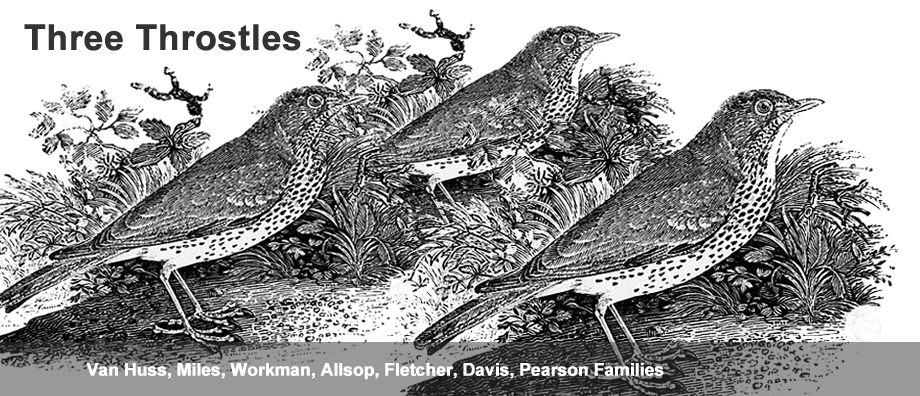Caveat: The names are spelled variously according to where Jan and Volkje lived. The seaport in Nordfriesland where Jan came from is now spelled Husum, and is in north Germany on the Jutland Peninsula. In Frisian the town was spelled Hüsem.Volkje's name is spelled variously, as well as her place of birth, Nordstrand, an island off the Frisian coast near Husum. Their marriage certificate in Amsterdam spells the last name Hussum. The name evolved as branches of the family got further away from New York and moved to Pennsylvania, then to North Carolina, Virginia, Tennessee, Texas, and Kansas.
VAN HOOSE VAN HOOSER VAN HUSS FAMILY IN AMERICA by Joyce Lindstrom
On June 5, 1662, at Claverack on the Hudson, Jan Franse Van Hoesen bought from the Mahican Indians about half the present Columbia County including the site of the city of Hudson. The purchase price was 500 guilders in beavers, although one must wonder why the Indians needed beaver and not vice versa. Then again beaver to an Indian is more meaningful as a unit of exchange than paper or metal guilders. Ref-'The Albany Protocal, pp 566-575. The tract took in three clavers and extended southward to van Slechtenhorst’s land (about two miles of river shoreline) and eastward an uurgaan,or “hour’s going” (3 miles), over to the big Claverack creek.
Two Mahicans showed up before Johannes Provoost, clerk at the court of Fort Orange and the village of Beverwijck to affirm the sale, the two Indians being: one named Pamitepiet or in Dutch Kesjen Wey, and the other Hans Vos or in Indian Tatankenat.
The Will of Jan Fransz van Hoesen and his Wife, Volkje: A Case Study by Ruth Piwonka, HollandSociety.org Winter 2011
No one lives forever, and Jan Fransse Van Hoesen, ten years shy of his allotted three score and ten, preceded his wife in death, executing a joint will her, possibly on the evening of the 29th or the morning of the 30th of November, 1665, when Jan passed away "at about eleven o'clock in the forenoon". The will was drafted by a notary, Van Schelluyne.
JAN FRANSSE VAN HOESEN'S WILL
In the name of God, Amen. (On this day appeared) Jan Fransz van Hoesen and Volckie Jurriaens of. van Noortstrant, husband and wife, residing in Albany (known to the undersigned witnesses), he, van Hoesen, lying abed sick and she, Volckie Jurriaens, being sound of body, but both of them being in full possession and having the full use of their faculties, mind, memory and understanding, as far as outwardly appeared and could be observed, which appears, considering the shortness and frailty of human life, the certainty of death and the uncertain hour thereof, and wishing therefore to forestall the same by proper disposition of their temporal estate to be left behind, declared that without inducement, persuasion, or misleading on the part of any one, they had made, ordained and concluded this, their joint, reciprocal and mutual last will and testament, in form and manner as follows:
First and foremost they commend their immortal souls when they shall leave their bodies to the gracious and merciful hands of God, their Creator and Redeemer, and their bodies to a Christian burial; and whereas they, the testators, acknowledge that before the date hereof they had neither jointly nor severally made or executed any testamentary disposition, legacies, donations, or other bequests whatsoever, therefore, the said testators hereby declare that they hereby nominate and institute the survivor of both of them as his or her sole heir to all the property, real and personal, claims, credits, money, gold, silver, coined or uncoined, jewels, clothing , linen, woolens, household effects, etc., nothing excepted or reserved, which he or she who dies first shall vacate at death and leave behind, to do therewith as with his or her own free property , without contradiction or gainsay by any one, provided that the survivor of the two shall be held to bringup the six minor and unmarried children, namely, JURIAEN, aged 23 years; MARYA, aged 14 years; CATARINA, aged 12 years; JOHANNES, aged 10 years; JACOB, aged 8 years; and VOLCKERT, aged 7 years, until they are of age to marry; to rear them in the fear of the Lord and to train them and have them trained in an honest trade or profession whereby in due time they may earn their living and then, when they reach their majority, to turn over them as much as their two married children, to wit, Styntie Jans and Annetie Jans, have received, or the value thereof, with which the said testators consider that the survivor of them may suffice. Therefore, the survivor of the two shall be held to bind therefor especially their real and immovable property, such as houses and lands, both the house and lot situated here near the fort and the land lying below the fort. Furthermore, the testators hereby exclude and shut out the honorable orphan-masters and ever one else from the guardianship of the aforesaid children,and the administration of their estate, not being willing that they shall meddle therewith, and in their place they nominate and appoint the survivor of both of them as guardian.
We, the undersigned, declared for the honest truth that what is hereinbefore written is the last will and desire of the aforesaid testators, stated clearly and with due understanding of its meaning by both of them, which they caused to be reduced to writing as hereinbefore stated, and that, when the writing had progressed as far as above, the testator, Jan Fransz van Hoesen, wanted to get up from his bed and sit near the fire, where, on being taken there and put in a chair, he suddenly and unexpectedly gave up the ghost and died. Actum in Albany, on Monday the 20/30th of November 1665, at about eleven o'clock in the forenoon.
Cornelus Tonisen Bos Anthony Jansz D.V. Schelluyne, Secretary











